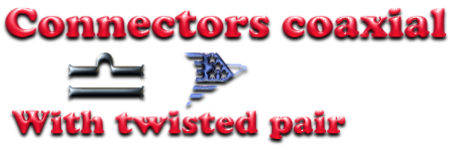Posts Tagged ‘onsite computer repair’
Cabling and connectors coaxial with twisted pair


The most significant target with the network adapter card would be to optimize network effectiveness and lessen the level of time essential to transfer knowledge packets throughout the network. The key is always to assure you obtain the fastest credit card you’ll be able to to the sort of network you’re on. For instance, if your wi-fi network supports 802.11b/g, make sure to have an 802.11g card since it’s faster. When the info is passing by means of the OSI design and reaches the Actual layer, it must uncover its way onto the moderate which is accustomed to physically switch files from laptop or computer to computer system. This channel is cable or inside the event of wireless networks, the air. It’s the NIC’s position to arrange the information for transmission, but it is the cable’s position to properly shift the info to its intended destination. It truly is not as basic as just plugging it into the laptop. The cabling you select need to assistance each the network architecture and topology. You will find four most important kinds of cabling approaches: coaxial cable, twisted-pair cable, fiber-optic cable, and wireless. We’ll summarize all four cabling techniques soon after the brief descriptions that follow.
Coaxial cable (or coax) contains a center conductor fabricated from copper, surrounded by a plastic jacket, with a braided shield through the jacket. Both Teflon or even a plastic including PVC covers this metal shield. The Teflon-form covering is often referred to like a plenum-rated coating. That quickly signifies that the coating doesn’t generate poisonous gas when burned as PVC does and is rated for use in ventilation plenums that carry breathable air. This style of cable is extra costly but could be mandated by electrical code whenever cable is concealed in walls or ceilings. Plenum rating applies to all sorts of cabling. Coaxial cable is available in several specifications which are rated according to your RG Variety method. Distinct cables have unique specifications and, for that reason, various RG grad- ing designations in accordance on the U.S. navy specification MIL-C-17. Distance and price tag are concerns when deciding on coax cable. The thicker the copper, the farther a sign can vacation—and with that can come a higher price tag and also a much less-adaptable cable.
Coaxial cable arrives in a lot of thicknesses and forms. The most prevalent use for this style of cable is Ethernet 10Base2 cabling. It truly is referred to as thinner or less expensive net. Argument over the that means in the abbreviation BNC. We have now heard Bayonet Connector, Bayonet Nut Connector, and British Naval Connector. What exactly is related is always that the BNC connector locks securely using a quarter twist movement. With Thick Ethernet, a station attaches to the major cable through a vampire tap, which clamps onto the cable. A vampire faucet is so named since a metal tooth sinks into the cable, thus generating the connection aided by the internal conductor. The tap is connected to an external transceiver that in turn features a 15-pin AUI connector also referred to as DIX or DB-15 connector to which you attach a cable that connects towards the station. DIX acquired its identify from your companies that worked on this structure Digital, Intel, and Xerox. Twisted pair is probably the most popular form of cabling to utilize as a result of its flexibility and minimal value. It consists of a number of pairs of wire twisted round one another inside of an insulated jacket. Twisted pair is most typically found in 100BaseT Ethernet networks, even though other techniques can use it. We find two distinct types of twisted-pair: shielded twisted-pair (STP) and unshielded twisted-pair (UTP). Both forms of cable have two or four pairs of twisted wires going through them. The difference is always that STP has an excess layer of braided foil shielding surrounding the wires to decrease electrical interference. UTP features a PVC or plenum coating, but no foil shield. UTP can come in 7 grades to present different stages of security in opposition to electrical interference. Category 5e is capable to transmit information at speeds as much as 1Gbps. It also contains 4 twisted pairs of copper wire, but they may be bodily separated and contain more twists for every foot than Category five to provide maximum interference security. Computer category six is capable to transmit info at speeds approximately 1Gbps and beyond. It also contains four twisted pairs of copper wire, and they may be oriented in a different way than in Category 5 or 5e. You may use it as being a backbone to connect diverse components within your network collectively, for example those people on different floors of your making. If you’re proceeding to install a new community, there’s no cause to make use of nearly anything but CAT-half a dozen except you decide on to make use of fiber. Just about every of these levels includes a optimum transmission distance of a hundred meters.



